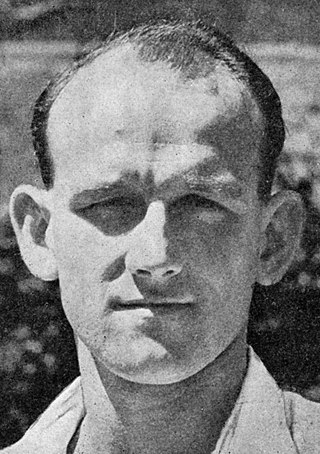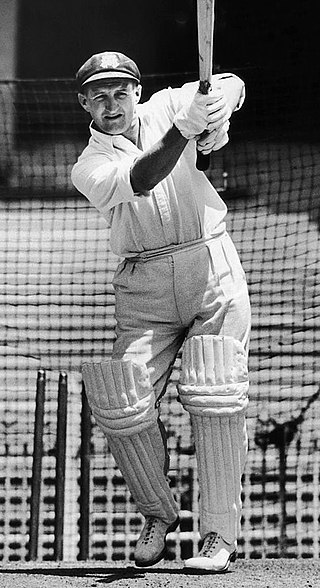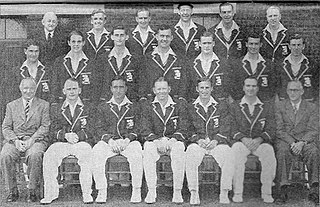
Sunil Manohar Gavaskar is an Indian cricket commentator and former captain of the national cricket team who represented India and Bombay from 1971 to 1987. Gavaskar is acknowledged as one of the greatest opening batsmen of all time.

Frederick Sewards Trueman, was an English cricketer who played for Yorkshire County Cricket Club and the England cricket team. He had professional status and later became an author and broadcaster.

Sir Leonard Hutton was an English cricketer. He played as an opening batsman for Yorkshire County Cricket Club from 1934 to 1955 and for England in 79 Test matches between 1937 and 1955. Wisden Cricketers' Almanack described him as "one of the greatest batsmen in the history of cricket". He set a record in 1938 for the highest individual innings in a Test match in only his sixth Test appearance, scoring 364 runs against Australia, a milestone that stood for nearly 20 years. Following the Second World War, he was the mainstay of England's batting. In 1952, he became the first professional cricketer of the 20th century to captain England in Tests; under his captaincy England won the Ashes the following year for the first time in 19 years.

Albert Neilson Hornby, nicknamed Monkey Hornby was one of the best-known sportsmen in England during the nineteenth century excelling in both rugby and cricket. He was the first of only two men to captain the country at both rugby and cricket but is also remembered as the England cricket captain whose side lost the Test match which gave rise to the Ashes, at home against the Australians in 1882. Additionally, he played football for Blackburn Rovers.

Norman Walter Dransfield Yardley was an English cricketer who played for Cambridge University, Yorkshire County Cricket Club and England, as a right-handed batsman and occasional bowler. An amateur, he captained Yorkshire from 1948 to 1955 and England on fourteen occasions between 1947 and 1950, winning four Tests, losing seven and drawing three. Yardley was named Wisden Cricketer of the Year in 1948, and in his obituary in Wisden Cricketers' Almanack he was described as Yorkshire's finest amateur since Stanley Jackson.

Frank Holmes Tyson was an England international cricketer of the 1950s, who also worked as a schoolmaster, journalist, cricket coach and cricket commentator after emigrating to Australia in 1960. Nicknamed "Typhoon Tyson" by the press, he was regarded by many commentators as one of the fastest bowlers ever seen in cricket and took 76 wickets at an average of 18.56 in 17 Test matches.

Richard Gorton Barlow was a cricketer who played for Lancashire and England. Barlow is best remembered for his batting partnership with A N Hornby, which was immortalised in nostalgic poetry by Francis Thompson. He was also an umpire and a football referee, including at the record 26–0 score between Preston North End and Hyde in the FA Cup.

Johnny Wardle was an English spin bowling cricketer whose Test Match career lasted between 1948 and 1957. His Test bowling average of 20.39 is the lowest in Test cricket by any recognised spin bowler since the First World War.

Alfred Louis Valentine was a West Indian cricketer in the 1950s and 1960s. He is most famous for his performance in the West Indies' 1950 tour of England, which was immortalised in the Victory Calypso.

The Prime Minister's XI or PM's XI is an invitational cricket team picked by the Prime Minister of Australia for an annual match held at the Manuka Oval in Canberra against an overseas touring team. The Australian team usually consists of up-and-coming grade cricketers from the Canberra region and state players.

Leslie Ernest Favell was an Australian cricketer who played in 19 Test matches between 1954 and 1961. South Australia's fourth highest run scorer, Favell was a much loved character and a daring batsman who liked to hit the ball around the ground.
Sonny Ramadhin, CM was a West Indian cricketer, and was a dominant bowler of the 1950s. He was the first of many West Indian cricketers of Indian origin, and was one of the five Wisden Cricketers of the Year in 1951. He is most famous for his performance in the West Indies' 1950 tour of England, which was immortalised in the song "Victory Calypso". He was also well known for his ability to turn the ball both ways and he was also largely known for using three short-legs along with close in fielders on the off-side during his playing days in order to exert more pressure on the batsmen. He was referred to as "a small neat man whose shirt-sleeves were always buttoned at the wrist". He was the last surviving member of the 1950 West Indies team that secured the West Indies' first-ever Test series win in England.

Alfred Mynn was an English first-class cricketer during the game's "Roundarm Era". He was a genuine all-rounder, being both an attacking right-handed batsman and a formidable right arm fast bowler. Cricket writer John Woodcock ranked him as the fourth greatest cricketer of all time. Simon Wilde wrote of him: "The speed at which Mynn bowled... and his life-size personality captured the imagination of the public in a way no cricketer had before."

Freddie Brown captained the English cricket team in Australia in 1950–51, playing as England in the 1950-51 Ashes series against the Australians and as the MCC in their other matches on the tour. They were regarded as a weak team - some critics wanted to cancel the tour - and failed to regain the Ashes. However, these facts do not tell the whole story as the inspirational Brown exposed flaws in the powerful Australian team. By winning the Fifth and final Test he ended Australia's record of 26 Tests without defeat and paved the way for England's victories in 1953, 1954-55 and 1956.
Len Hutton captained the English cricket team in Australia in 1954–55, playing as England against Australia in the 1954–55 Ashes series and as the MCC in other matches on the tour. It was the first time that an England team had toured Australia under a professional captain since the 1880s. After losing the First Test by an innings, they beat Australia 3–1 and retained the Ashes. The combination of Frank Tyson, Brian Statham, Trevor Bailey, Johnny Wardle and Bob Appleyard made it one of the strongest bowling sides to tour Australia, and it was the only team of any nationality to defeat Australia at home between 1932–33 and 1970–71.
The Pakistani cricket team toured England in the 1954 season. The team played four Test matches against England, winning one, losing one and drawing two. These were the first Test matches played between the two sides. In winning the fourth and final Test, Pakistan became the first side to win a Test on its inaugural tour of England.
The West Indies cricket team toured England in the 1950 season to play a four-match Test series against England.

The 1954–55 Ashes series consisted of five cricket Test matches, each of six days with five hours play each day and eight ball overs. It formed part of the MCC tour of Australia in 1954–55 and the matches outside the Tests were played in the name of the Marylebone Cricket Club. The England team was captained by Len Hutton, the first professional cricketer to lead an MCC tour of Australia. The Australian team under Ian Johnson was confident of victory, but despite losing the First Test by an innings England won the series 3–1 and retained the Ashes. They were the only touring team to win a series in Australia between 1932–33 and 1970–71 and only the second of three touring teams to win a series in Australia from behind. The tour is best remembered for the bowling of Frank "Typhoon" Tyson, who was at the time regarded as the fastest, most frightening bowler ever seen in Australia. The series saw a phenomenal concentration of bowling prowess on both sides – four of the bowlers had career Test averages under 21, another five under 25 and the remaining four under 30. Unsurprisingly therefore, the ball dominated the bat for most of the series and each side only topped 300 in an innings twice. Unlike the following series in 1958–59 there were rarely any umpiring disputes and Keith Miller wrote "Mel McInnes, Colin Hoy and Ron Wright were our leading umpires in the 1954–55 M.C.C. tour of Australia, and I have no hesitation in saying that McInnes gave the finest exhibition of umpiring in a Test series that I have experienced".

The Marylebone Cricket Club tour of Australia in 1954-55 under the captaincy of Len Hutton was its eleventh since it took official control of overseas tours in 1903-04. The touring team played as England in the Ashes series against Australia, but as MCC in all other games. In all there were 23 matches; 5 Test matches, 12 other First Class matches and 6 minor matches. It was the only time that a professional cricketer captained an MCC tour of Australia. It was one of the MCC's most successful tours, the Ashes being retained and the team winning five of their victories by an innings.
W. G. Grace is believed to have considered retirement from cricket before the 1878 season after he was seriously injured in a shooting accident the previous autumn which nearly cost him the sight of an eye. Having recovered, he reconsidered and in 1878 played in 33 matches, 24 of which are generally recognised as first-class. His main roles in the season were captain of Gloucestershire County Cricket Club and both match organiser and captain of the United South of England Eleven (USEE). In addition, he represented Marylebone Cricket Club (MCC), the Gentlemen in the Gentlemen v Players fixture and the South in the North v South series. 1878 was a cold, wet summer and not one of Grace's better seasons as a batsman, but he was very effective in such conditions as a right arm medium pace roundarm bowler and completed a sixth successive "double" by scoring 1,151 runs and taking 152 wickets in the recognised first-class matches.














